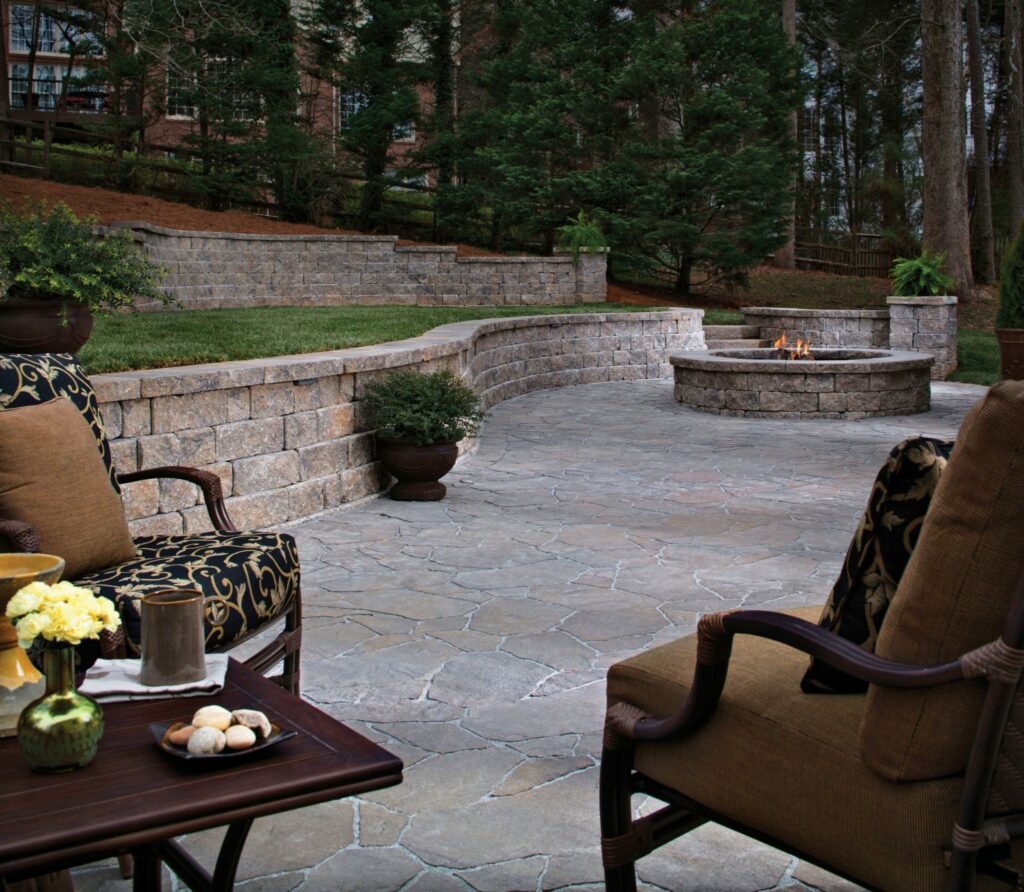Quick Answer
Looking to solve slope challenges while creating stunning landscape features that enhance your property’s elegance and value?
Retaining walls combine essential structural functionality with high-end design elements through premium materials, expert engineering, and artistic craftsmanship. These installations solve drainage and erosion issues while creating dramatic focal points that showcase natural stone, custom lighting, and integrated landscaping that transforms challenging terrain into outdoor masterpieces.
Read on for comprehensive insights into material selection, design strategies, and professional installation techniques that will transform your slope challenges into landscape assets.
Introduction
Retaining walls are one of the most transformative elements in luxury landscape design, solving critical structural challenges while creating opportunities for dramatic aesthetic enhancement. Far from simple utility installations, today’s retaining walls function as architectural features that define outdoor spaces, create usable areas from challenging terrain, and showcase premium materials and craftsmanship.
Charlotte’s varied topography presents numerous opportunities for retaining wall applications, from gentle slope management to dramatic grade changes that require sophisticated engineering solutions. The region’s clay soil conditions and intense rainfall patterns make proper retaining wall design essential for long-term landscape stability and property protection.
Modern retaining wall design has evolved to integrate structural engineering with artistic vision, creating installations that serve multiple functions while enhancing property value and outdoor living potential. These structures often complement other luxury features, like high-end outdoor kitchens by creating defined spaces and managing grade changes around entertaining areas. These projects require careful coordination between engineering requirements and design aspirations to achieve results that are both beautiful and enduring.
This comprehensive guide covers:
- Premium materials that combine durability with aesthetic appeal
- Design strategies that maximize both function and visual impact
- Structural engineering principles essential for long-term performance
- Integration techniques for lighting, drainage, and landscaping
- Professional installation benefits that ensure optimal results
- Charlotte-specific considerations for soil and climate conditions

The Engineering Foundation: Why Structure Comes First
Successful retaining walls begin with sound engineering principles that ensure structural integrity and long-term performance. Without proper structural design, even the most beautiful materials and craftsmanship will fail over time, creating costly repairs and safety hazards.
Engineering and Drainage: The Foundation of Success
Charlotte’s expansive clay soils present unique challenges requiring a specialized understanding of soil mechanics and drainage management. Clay soils exert significant lateral pressure against retaining structures, particularly during wet periods when soil moisture content increases.
Critical Engineering Elements:
- Proper foundation depth and reinforcement for local soil conditions
- Comprehensive drainage systems that prevent hydrostatic pressure buildup
- Structural design accommodating thermal expansion and soil movement
- Professional engineering ensuring long-term stability and performance
Without adequate drainage, even the most beautiful materials and craftsmanship will fail over time. Professional installation includes perforated drainpipes, drainage aggregate backfill, and surface water management that prevents pressure buildup while maintaining landscape aesthetics.
Premium Materials: Where Function Meets Artistry
Material selection for retaining walls requires balancing structural performance with aesthetic appeal. Premium materials not only provide superior durability but also offer unique visual qualities that distinguish custom installations from standard utility walls.
Natural Stone: Timeless Elegance with Structural Integrity
Natural stone materials provide unmatched beauty and exceptional durability for retaining wall applications. Each stone type offers unique characteristics that influence both structural performance and aesthetic appeal.
Premium Stone Options:
| Stone Type | Structural Benefits | Aesthetic Qualities | Best Applications |
| Natural Fieldstone | Irregular shapes interlock naturally | Organic, rustic character | Curved walls, natural landscapes |
| Cut Limestone | Consistent dimensions enable precise construction | Clean lines, formal appearance | Straight walls, contemporary designs |
| Stacked Slate | Flat profiles create stable construction | Layered textures, color variations | Terraced installations, modern aesthetics |
| Boulder Walls | Massive stones provide exceptional stability | Dramatic scale, natural fortress appearance | Large installations, specimen features |
Natural stone selection depends on both aesthetic preferences and structural requirements, with professional selection considering wall height, soil conditions, and design objectives.

Engineered Block and Concrete Systems
Modern engineered block systems combine precise manufacturing with design flexibility and integrated drainage features. High-end blocks feature sophisticated textures and colors that replicate natural stone while providing consistent dimensions.
Architectural concrete offers unlimited design possibilities through custom forming, integral coloring, and surface treatments. Options include stamped patterns, exposed aggregate finishes, and custom forming enabling curved or stepped configurations.
Design Strategies: Creating Visual Impact Through Thoughtful Planning
Retaining wall design requires strategic planning that maximizes both functional performance and visual impact. Successful installations integrate structural requirements with landscape design objectives to create features that enhance rather than dominate outdoor spaces.
Design Strategy: Maximizing Visual Impact
Wall height significantly influences both structural requirements and visual impact. Walls exceeding four feet typically require professional engineering, while taller installations benefit from terraced designs that reduce structural loads while creating interesting visual compositions.
Key Design Elements:
- Curved alignments providing superior structural stability and organic appearances
- Strategic height variations following natural topography
- Material transitions and accent features adding visual interest
- Integrated elements like cap stones, planter pockets, and lighting integration
Professional design ensures these elements enhance rather than compromise structural performance while creating cohesive appearances that complement surrounding landscape features.

Lighting Integration: Enhancing Safety and Drama
Strategic lighting integration transforms retaining walls from daytime landscape features into dramatic nighttime focal points while providing essential safety illumination for level changes and pathway connections. Similar to how luxury patio design trends incorporate immersive lighting, retaining walls benefit from thoughtful illumination planning.
Safety and Accent Lighting Integration
Retaining walls create level changes requiring adequate lighting for safe navigation while providing opportunities for dramatic accent effects. When properly designed alongside features like outdoor kitchen layouts, retaining wall lighting creates cohesive illumination schemes.
Lighting Applications:
- Step and path lighting for safe navigation and clear level indication
- Uplighting highlighting stone textures and construction details
- Integrated wall lighting built into construction for seamless appearances
- Motion-activated systems providing security while conserving energy
Professional installation ensures proper electrical coordination, clean appearances, and long-term maintenance accessibility.
Comprehensive Drainage: Critical for Long-Term Success
Drainage design represents the most critical aspect of retaining wall performance. Charlotte’s clay soils and rainfall patterns require comprehensive systems managing both surface and subsurface water.
Essential Drainage Elements:
- Surface grading directing water away from wall areas
- French drain systems collecting and directing groundwater
- Drainage aggregate providing permeable zones
- Geotextile fabrics preventing soil migration while allowing water passage
Professional installation includes systematic testing ensuring drainage systems function properly before completion, preventing future problems that could compromise performance.
Plant Integration: Softening Structure with Living Elements
Strategic plant integration softens retaining wall appearances while providing additional erosion control and aesthetic enhancement. Professional landscape design coordinates plant selection with wall construction to ensure compatibility and optimal performance.
Plant Integration: Softening Structure with Living Elements
Terraced retaining wall installations create planting opportunities that maximize green space while providing erosion control. For low-maintenance options, artificial turf can be integrated into terraced areas for consistent coverage without irrigation concerns.
Integration Strategies:
- Native plant selection requiring minimal maintenance
- Built-in planter pockets designed during construction
- Root system considerations preventing structural compromise
- Irrigation integration supporting plant health while managing water appropriately
Professional design ensures plant integration enhances rather than compromises structural performance.

Professional Installation Benefits: Why Expertise Matters
Retaining wall installation requires specialized knowledge, equipment, and experience that professional contractors provide. The complexity of integrating structural engineering, drainage systems, and aesthetic elements demands expertise that ensure optimal results.
Professional Installation Benefits: Why Expertise Matters
Retaining wall installation requires specialized knowledge, equipment, and experience. Walls exceeding certain heights require professional engineering and permit approval, while complex installations demand expertise in material handling, precise grading, and systematic construction sequencing.
Professional Advantages:
- Structural engineering and permit coordination
- Specialized equipment for efficient material placement
- Quality control processes maintaining standards throughout installation
- Long-term warranties protecting investment value
Professional contractors provide ongoing support for maintenance, repairs, and future modifications while ensuring compliance with local codes and safety standards.
Charlotte Climate Considerations and Maintenance
Charlotte’s humid subtropical climate presents specific challenges and opportunities for retaining wall installations. Understanding local conditions ensures optimal material selection and maintenance strategies.
Charlotte Climate and Maintenance Considerations
Charlotte’s climate variations require designs accommodating thermal expansion and moisture cycling. Professional design includes appropriate material selection and construction techniques handling high humidity, intense rainfall, and occasional freezes.
Maintenance Requirements:
- Drainage system inspection and cleaning
- Joint maintenance preventing water infiltration
- Plant management maintaining appropriate growth
- Surface cleaning preserving material appearance
Regular professional inspection identifies potential issues early, protecting long-term investment value and performance.
FAQ
In Charlotte, retaining walls over four feet typically require professional engineering and permits. However, even shorter walls benefit from professional design to ensure proper drainage, foundation requirements, and long-term performance in local soil conditions.
Material selection depends on wall height, soil conditions, aesthetic preferences, and budget considerations. Professional evaluation considers structural requirements, drainage needs, and design objectives to recommend optimal material choices for specific applications.
Properly designed and installed retaining walls can last 50+ years with appropriate maintenance. Material quality, installation craftsmanship, and drainage system effectiveness are the primary factors determining longevity and performance.
Yes, retaining walls can be successfully integrated into existing landscapes through careful planning and professional installation. Site evaluation determines optimal placement while minimizing disruption to established features and drainage patterns.
Maintenance requirements include periodic drainage system inspection, joint maintenance, plant management, and surface cleaning. Professional maintenance programs ensure continued performance while protecting investment value over time.
Conclusion
Retaining walls are one of the most impactful investments homeowners can make to address slope challenges while creating stunning landscape features that enhance both property value and outdoor living potential. The combination of structural engineering, premium materials, and artistic design creates installations that solve practical problems while delivering exceptional aesthetic appeal.
The evolution toward integrated design approaches that coordinate drainage, lighting, and landscaping has transformed retaining walls from purely functional necessities into central elements of luxury landscape design. When professionally designed and installed, these features provide decades of reliable performance while showcasing exceptional craftsmanship and materials.
For Charlotte homeowners seeking to transform challenging terrain into luxury landscape assets, professional retaining wall design and installation provides the expertise necessary to achieve results that combine engineering excellence with artistic vision.
